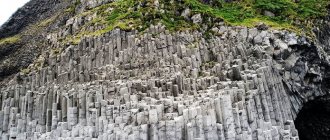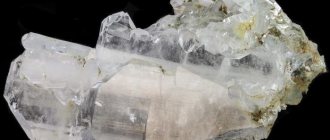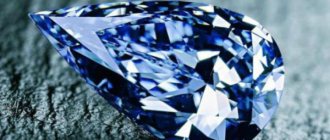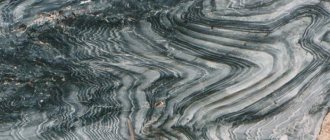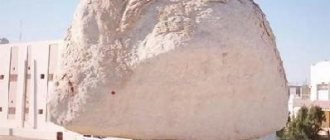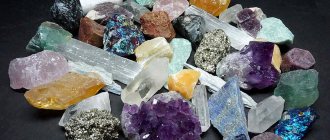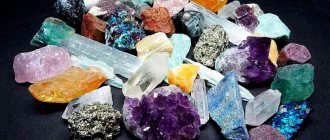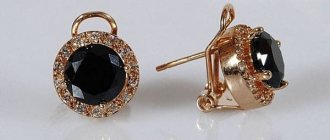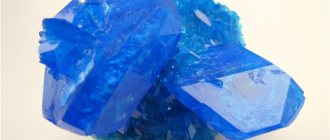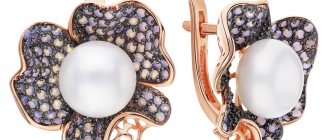Minerals have been known to people for tens of centuries. Since ancient times, precious stones and precious metals have been objects of passionate desires of representatives of different nations, thereby often determining the course of history. Gems, the color of which varies depending on the presence of chromophores in the composition, still amaze today with their beauty and incredible ability to effectively reflect light flows falling on them. And these are not all the properties of chemical elements created by nature, the mysterious power of which rarely leaves anyone indifferent. We present to your attention only the most interesting facts about minerals.
Interesting information
- Almost all minerals have molecules arranged in a crystal lattice.
- Jade is approximately twice as strong as steel. In the Middle Ages, a musical instrument was made from it; thin jade plates were hung on silk threads and struck with a hammer.
- Diamond and graphite are allotropes of the same substance – carbon. The crystal lattice of diamond is extremely strong, while that of graphite is fragile, so it leaves a mark if it is drawn across paper (the leads of simple pencils are made of graphite).
- Emerald and aquamarine are the same minerals, they differ only in color. Emerald contains green chromium, and aluminum gives aquamarine its blue color.
- There is an interesting case in history. When Mikhail Lomonosov identified minerals from the collection of the Academy of Sciences, he did not guess only one stone, a gift from the Polish king Jan Sobieski. It was a stone removed from his kidney.
- Red corals grow in the Mediterranean Sea. They are used to make jewelry; in Ukrainian, beads are called “corals”, as in the past they were made from beads made from red corals.
Interesting facts about gems and precious stones
Rocks consist of minerals, more often of several types, less often of one. Gems are also minerals.
Most minerals have a crystalline structure. Crystallization of minerals occurs in the earth's crust as rocks containing them emerge from the depths to the surface. Giant crystals reach 1-2 m in length, but have the same structure as 5 cm crystals.
A unique collection of rough giant gems is kept in the Natural History Museum in Paris. A hollow piece of rock whose inner walls are studded with crystals is called a geode. In the museum you can see a 2,500 kg geode found under the city of San Gabriel in Brazil, as well as a fragment of another geode that weighed 35,000 tons.
Giant crystals from the banks of the Doce River (Brazil) are considered the most beautiful in the world. The rocks from which they are extracted are at least 400-500 million years old.
Rubies and sapphires
See details on how to set up an hp laserjet 1018 printer on the website. Go to the website https://casino-vulkan.games/ and get a good registration bonus!
Ruby and sapphires are varieties of the colorless mineral corundum. Certain impurities give them different colors. The red color of ruby is due to the presence of chromium, while iron and titanium color sapphire crystals yellow, green and blue.
Beryl crystals are colorless; the metal chromium turns them into green emeralds. These gems often have foreign inclusions that somewhat impoverish their beauty. However, it is precisely by these that one can determine the deposit of stones. The most beautiful emeralds are mined in Colombia.
Diamond is the hardest stone. They can cut glass and crush rocks. Diamonds are colorless, yellow, brown, pink, green and blue. Diamonds are cut diamonds. Most diamonds are mined from kimberlite, a rock first discovered in a volcanic pipe beneath Kimberley, South Africa.
Kunzite
Kunzite is a precious stone characterized by beautiful coloring and high transparency. Usually its color is soft pink or purple, but sometimes manganese impurities can give it a lilac or bluish-purple color.
Amethyst
Amethyst is a clear purple variety of quartz.
Asterism – natural “star-like” appearance of gems
Some minerals have a special decorative effect - from different angles and when moving the gem, a star of 3, 4 or more rays is visible in it (up to 12 rays in rubies). The nature of this phenomenon is due to the fact that crystals often contain inclusions of other crystals. Light, refracting in them in a special way, creates a star pattern that can be observed in corundum, ruby, beryl, emerald, aquamarine, sapphire, heliodor, diopside. Artificially grown stones can also be given this effect through various inclusions during their production.
Children about minerals. A list of entertaining and colorful books on mineralogy and geology for children
All these books are written in a language that children can understand and contain very bright and large illustrations. It will be interesting for both children and parents.
1. “Minerals. 100 facts." S. Calleri You will learn how geologists restore the ancient history of the Earth, what composition our planet has, what are the similarities and differences between stalactites and stalagmites, what kind of minerals are part of unique architectural monuments, what properties can be used to distinguish outwardly similar minerals, why they are so valued precious stones and how they are obtained.
2. “The World of Stone.” V. Schumann In a simple and very accessible form, the author talks about the processes in the earth's crust, the properties of mineral matter and methods of studying it, gives brief characteristics of the main minerals, rocks, fossil remains (fossils). The book contains a lot of well-chosen, effective color illustrations.
3. “The Stone Has Its Own Story” by Dianna Aston and Sylvia Long A book from a series of art books by Dianna Aston. There is a whole collection here: from sandstone and granite to bright blue azurite and snow obsidian. An amazingly beautiful book for both children and adults! This book will allow you to learn to feel nature and see its beauty.
4. “Stones and Shells” by M. Zellvelder A book from the “World of Wildlife” series will help the young reader “look” inside our planet and learn about volcanoes, glaciers, rocks and fossil remains.
5. Children's encyclopedia "Minerals" T. Dolzhanskaya Clay and sand, stones and asphalt, mountains and water, minerals in the bowels of the planet - all these are minerals.
Learn more amazing facts about our planet in the “Geological Laboratory” classes for children 7-12 years old from November 17.
Choosing the right stone
When choosing a talisman for yourself, astrologers recommend relying on zodiac signs, date, and month of birth. Choosing a talisman is somewhat easier. To do this, you need to determine what you should protect yourself from.
Read also: Mehndi was made in Ancient Egypt about 5 thousand years ago
The most powerful amulets are those given by loving people from the heart. Also good are those talismans that were literally given by fate or appeared in life under strange circumstances.
Diamonds
Diamond is the hardest substance on the planet. Therefore, a diamond can only be polished or sawed using another diamond.
Black diamonds are much more common in nature than light-colored diamonds and are used in the manufacture of sandpaper.
Scientists have learned to create artificial diamonds; they are as hard as real ones. They produce not only industrial diamonds, but also jewelry ones.
The technology for making artificial diamonds is complex - carbon is heated to high temperatures under high pressure.
In Russia, the largest diamond deposits are located in the Republic of Sakha (Yakutia).
The most interesting specimens
Vanadinite stone holds the title of the heaviest mineral on the planet. The yellow-red crystal is named after the Scandinavian goddess of beauty. The high concentration of lead in barrel-shaped stones makes them quite dense and hard. The brittle mineral formed by the oxidation of lead ore deposits is one of the unique collection materials.
Diamond is recognized as the most durable mineral not only on Earth, but also in the Universe. Transparent crystals of the material are formed based on carbon atoms. The most amazing thing is that despite the incredible hardness of the stone, diamond is very fragile: with a sharp and strong blow, it easily breaks into small pieces.
Cut diamonds – diamonds are also recognized as the most expensive minerals. Expensive stones are measured in carats. One carat corresponds to 0.2 grams.
World-famous diamonds, surrounded by myths and legends:
- Kullian is a colorless stone measuring 50x65x110 mm, on the basis of which 105 faceted diamonds were made. One of them, the “star of Africa,” adorns the scepter of Great Britain.
- Kohinoor is a colorless diamond discovered in India back in 800 AD. The legendary stone has changed many owners and has a rich history. Today it adorns the crown of Elizabeth, Queen of Great Britain.
Beautiful and dangerous
Not all minerals are safe for human health. A striking example of this is torburnite. When heated, the crystal emits a gas dangerous to human health - radon. Poisonous gas causes lung cancer. Radioactive elements affect hematopoietic and immune cells, which leads to the development of a wide variety of diseases.
The sulfide mineral of antimony, stibnite, is no less toxic. A hard, fragile stone in the form of needle-shaped crystals with a silvery sheen and a slight rainbow tint, upon contact with the skin it causes severe poisoning. Just 100 mg of Sb can become a lethal dose if it enters the human body.
Chalcanthite is another incredibly beautiful, but very dangerous stone, formed from short prismatic crystals of a sky blue, bright blue or greenish-turquoise hue. “Copper flower”, upon contact with liquid, releases toxic substances that threaten all living things that get in the way. A small blue stone thrown into a pond can destroy life in the entire reservoir. The human body’s reaction to the process is such that when interacting with a liquid poisoned by chalcanthite, vital internal organs fail.
Alexandrite – a chameleon stone
Alexandrite, named after Alexander II, was officially discovered in the Ural Mountains at the beginning of the 19th century. But its property of changing color in daylight and evening light has been known for a long time. It is no coincidence that in the East it was called “iridescent”. Other gems also have this property to some extent. Thus, aquamarine brightens a little in the sun, and peridot loses its yellowness in evening light.
2. The science that studies the physical and optical properties of precious stones is called gemology.
3. Absolutely all precious stones are mined by hand.
4. Prices for precious stones will only increase, because there are fewer and fewer real minerals on the planet.
5. 9/10 of all mined diamonds are used for production needs, and only 1/10 reaches jewelers and then consumers.
DIAMOND
6. Precious stones are quite complex in structure, with the exception of diamond. It is based on only one chemical element - carbon.
7. Depending on the shape of the diamond crystal, 55-70% of its weight is lost during processing.
8. The largest natural diamond ever found on our planet is the Cullinan diamond. Before division, its mass was 3106.75 carats (621.35 grams). In 1908, it was split into several large pieces, from which 9 large and 96 small diamonds were eventually made.
9. In 1694, Italian scientists John Averani and C. A. Tardgioni, while trying to fuse several small diamonds into one large one, discovered that when heated strongly, the diamond burned like coal.
10. Diamond will gradually transform into graphite if it is placed in a vacuum or in an inert gas at elevated temperatures.
ALEXANDRITE
11. Alexandrite is one of the few stones that changes its color. From green or blue (in daylight and sunlight) it becomes red or pinkish (in artificial light). Some garnets and sapphires behave in the same way.
12. Alexandrite was named after Tsarevich Alexander, the future Emperor Alexander II.
13. Different peoples of the world, living in different eras, treated emerald differently, but with equal respect. The ancient Greeks came up with a poetic name for it - the stone of radiance. Ancient Russians considered it one of the symbols of wisdom.
14. Indians traditionally presented emerald to newlyweds as a wedding gift, as they believed that it kept the spouses’ feelings “fresh” longer. 1
15. Emerald has long been considered a stone that protects its owner from damage. But our ancestors believed that it could only fully demonstrate these properties in a gold frame.
RUBIES
16.Ruby is considered a very rare and expensive stone.
17. At the same time, there is an entire ruby rock on the planet! It is located in Yakutia, but this huge thing may not be visible to the naked eye. The fact is that the rock is made up of tiny ruby crystals, which can only be distinguished under a microscope.
18. Ruby is a deep scarlet colored gemstone found almost everywhere. The only continent where its deposits have never been discovered is Antarctica.
19.95% of all rubies are artificially refined. Only truly large and perfectly beautiful stones can avoid such a fate.
20. Rubies and sapphires are the same stones. The only difference between them is the color. Rubies and sapphires are a variety of corundum. Red corundums are called rubies, blue ones are called sapphires.
21.The red color of ruby is given by an admixture of chromium, and the blue color of sapphire is caused by the presence of impurities of titanium and iron.
22.Traditionally, these stones are exported from Thailand, Tajikistan, Sri Lanka, Kenya and Tanzania. Rubies from Asia are considered the highest quality and, accordingly, the most expensive.
23. It is no coincidence that ruby is considered the royal stone. He was worshiped by many historical figures. Cleopatra, Cardinal Richelieu, Mary Stuart and Marie de Medici had their own collections of rubies.
24. And our contemporary - British Queen Elizabeth II - in 1973 ordered a luxurious ruby tiara from court jewelers. The jewelry was made from stones given to her by the Burmese as a wedding gift. And the entire jewelry collection of Queen Elizabeth II of England costs about $57 million.
EMERALD
25. Large, defect-free emeralds of a dense tone weighing from 5 carats are valued more than diamonds.
26. The largest emerald crystal was mined in 1974 in Brazil, its weight was 28 kilograms.
27. Aquamarine and emerald are the same stone, just the admixture of different chemical elements gives different colors. Chrome turns emerald green, and aluminum turns aquamarine blue.
28. Almost all emeralds have cracks and inclusions (according to various sources, 90–95%). But this does not reduce their value, because the stone is evaluated by color and saturation.
29. To extract just one carat of emerald, about 20 tons of soil are dug up in mines in Colombia.
30.The term "ornamental stone" refers to minerals and rocks that are used as inserts in jewelry or for the production of stone-cutting products. Sometimes less valuable or opaque stones are called ornamental.
GEMS
31. Gems are precious, semi-precious and ornamental stones that are used as jewelry and ornamental raw materials. They are usually transparent or translucent.
32. Sapphire is usually represented as a deep blue stone. In fact, purple, pink, orange, yellow and even green sapphires are found in nature, and are collectively known as “fancy” sapphires. The only color not available to this stone is red.
33. Boris Godunov valued sapphires very much. He considered them magical, with many beneficial properties.
34. Many people mistakenly believe that diamonds are only colorless. In fact, the color palette of a diamond can be the envy of any precious mineral. But nowadays, not all colored diamonds have natural color. Many stones are artificially colored. This is due to their rarity.
35.Before the invention of the Mohs scale (mineralogical hardness scale), stones were identified by color. So all the green stones became emeralds, the red ones became rubies, etc.
BLUE TOPAZ
36. Topaz becomes dull and discolored in the sun. Therefore, jewelry containing this stone is not recommended to be worn on the beach.
37. Of the colored topazes, the rarest is pink. It is very difficult to extract such stones.
38. And the most fashionable topaz is a delicate pinkish-powdery shade of Misty Rose.
39. In order to distinguish a real diamond from its imitation, a special “diamond probe” is used to measure the thermal conductivity of the stone being examined. Diamond has a much higher thermal conductivity value than its substitutes.
40. In addition, the good wettability of the diamond with fat is used: a felt-tip pen filled with special ink leaves a solid line on the surface of the diamond, while on the surface of the imitation it crumbles into separate droplets.
BIXBIT
41. There is a “red emerald” stone. In fact, it is a red variety of beryl, bixbite. This is an extremely rare stone and is mined only in Utah (USA).
42. Pink topaz is the rarest colored variety of this gemstone. It is pink topazes that are most often counterfeited.
TANZANITE
43. The largest known topaz is called Eldorado topaz. The weight of the stone, stored in Brazil, is 31 thousand carats.
44. If opals are stored in low humidity conditions, loss of moisture may cause them to crack and become cloudy. Therefore, jewelry and jewelry with opals should be worn as often as possible, since the gemstone can take the moisture it needs from the air or the skin of the person who wears it.
45. Cubic zirconia, an artificial material that imitates a diamond, is widely used in jewelry. Its cultivation occurs in laboratory conditions, where the crystal growth rate is up to 8-10 mm/h.
AMBER
46. Amber is the name of the resin of coniferous trees, which has lain in the depths for about 30,000,000 years.
47. Amber in the open air actively oxidizes (aging), which over time leads to changes in the chemical composition, color and increased fragility.
48. The largest amber deposit is the Kaliningrad region. The amber plant in the village of Yantarny produces about 90% of the world's production of this stone.
KREMLIN RUBY STARS
49. The Kremlin stars were originally made from Ural gems, which did not stand the test of time and harsh Moscow weather conditions and became dim.
50. In 1937, the Soviet government decided to install new stars - resistant to temperature changes, durable and not losing their color. A talented master, specialist glassmaker Nikanor Kurochkin compiled a recipe according to which a special glass was welded - ruby. It was from this that the shining red stars that decorated the Kremlin towers were made.
photo from the Internet
The healing properties of gems - myth or reality?
Since ancient times, it was believed that minerals have the ability to cure diseases, bring good luck and money, and attract love to their owner. For example, they believed that they were endowed with such magical qualities:
- Carbuncle.
- Chrysolite.
- Coral.
- Pearl.
- Amethyst.
- Pomegranate.
- Agate.
- Sardonyx.
- Topaz.
- Turquoise.
- Sapphire and other stones.
And now the properties of gems are correlated with the signs of the Zodiac and it is recommended to carry “your” stone with you. According to the testimony of V. Dahl, it is known that A.S. Pushkin considered his emerald ring a talisman that bestowed talent. But there is no scientific proof of the healing power of stones. But lithotherapy is still widely used in folk medicine.
Origin of stone names
- African or Brazilian emerald refers to minerals that were mined in Africa and Brazil.
- There is a tradition of giving a name in honor of someone. So, for example, the stone was named Lomonosovite in honor of the scientist
- Labradorite is a mineral from the feldspar group of gray or blue-black color with bright and iridescent tints. It got its name from a deposit on the Labrador Peninsula.
- There is a huge group of minerals that bear geographical names. Alaskite was found in Alaska, andalusite was found in the Spanish province of Andalusia, vesuvianite was found on Mount Vesuvius, and cubanite was found in Cuba.
- Avicennite and birunite were named in honor of the great scientists of the Middle Ages, Biruni and Avicenna.
- It happens that the name of a mineral is made up not just by a person’s last name, but by a combination of his first name and last name. So, in honor of Henri Termier, a professor of geology from Paris, the mineral was named anrittermierite, and in honor of a professor from Chicago, Julian Goldsmith, the mineral was named julgoldite.
Application of minerals
Chemical preparations are made from many minerals, such as: saltpeter, organic sulfur, fluorspar, potassium, boron minerals, mercury, magnesium, sodium.
Read also: The Rubik's Cube was invented by an architect in 1974
The development of agriculture and stones are closely interrelated, because mineral fertilizers are created on their basis, such as potassium salts, silicates, apatites and phosphorites.
Some minerals and their chemical processing products are used to create medicines. Glauber's salt is created on the basis of mirabilite, and mineral waters are created on the basis of Borjomi and Narzan.
Interesting minerals are also used in the metallurgical industry. So, for example, vanadinite, rhodochrosite, dolomite, colemanite are used in this area. It is simply impossible to build a building without gypsum, dolomite and calcite.
Minerals that people use in the jewelry segment are divided into precious and ornamental stones. This is a wide range of their use.
Feldspar interesting facts. History and origin
The first finds and use of feldspar go back to ancient times. No one knows the exact time when the mineral was discovered. There are only scattered references to the stone in handwritten sources from different times.
The name “feldspar” is German, although it has Swedish roots. This is because the agricultural land located on the lands of modern Sweden is completely strewn with feldspar. Mineralogists believe the origin of the name is Swedish-German, where “feldt” means “arable land” and “spath” means bar. In 1740, the German term "feldspat" was introduced. In addition, scientists claim that the Russian-language term “cleavage” should have been pronounced as “spatnost”.
In mineralogy, feldspar is understood as a whole group of minerals. The origin of the stone is magmatic. In fact, feldspar is the rock-forming material of our planet. In its pure form, this nugget is inconspicuous. However, pure spar is rare. The bulk of stones include various impurities, which separates them by chemical composition, type, and name.
This is interesting! The Moon is rich in feldspar, like the Earth. This mineral is not uncommon in outer space - most meteorites contain feldspar.
The fact that spar has been used by people at all times is confirmed by archaeological finds during excavations. Nugget jewelry made by people of ancient civilizations has been found in Egypt and other Eastern countries. Scientists of all eras have studied the capabilities of this mineral. Research in this area is still being carried out.
Artifact of Xia Chenghong
Both the shape of this stone and the history of its appearance are strange. In shape it could be similar to a fossilized fragment of a UFO mechanism (if it existed) weighing 6 tons and 2.8 m high. The two oval parts of the “three-story” artifact seem to be connected (or separated) by columns, and they can also be seen at the top. According to media reports, the discovery was made by Chinese Xia Chenghong, who drove past a piece of rock sticking out of the ground in a car. It caught his attention and he stopped. Seeing that the stone was something interesting, the Chinese decided to become the owner of a rare artifact and bought this piece of land from a local farmer in order to transport the find to his plot. It took a long time to dig it out of the ground, and when it turned out that its size and weight exceeded expectations, a crane was used.
Now the find is on the owner’s personal property, and he refuses to either sell it for research or allow it to be studied on his territory. Therefore, it is not yet possible to identify the fragment either with the historical era or with the intended purpose. All that has been established with a relative degree of certainty is that the material of the incomprehensible artifact is basalt.
Galena interesting facts. Properties of galena
Lead luster (another common name for the mineral) has been known to mankind for quite some time. Even in the times of Ancient Rome, the rock was actively used to extract silver and other metals from it. In addition, galena was endowed with a lot of magical properties.
Galena stone
Today, jewelry with this mineral is rare, the reason for this is the difficulty in processing the material. But you can still find collections of designer jewelry that are inlaid with lead glitter. Since the mineral is mined all over the world, jewelers do not experience any particular shortage of galena.
The leading countries in production are the following:
- Italy.
- Czech Republic.
- Romania.
- Bulgaria.
- Australia.
- USA.
- Mexico.
- Canada.
- Chile.
- Russia.
In our country, the mineral is mined on an industrial scale in several regions.
The chemical formula of lead luster is PbS, but the mineral is rarely found in nature in its pure form. Most often it contains silver, which is why the mining of galena is so widespread. Geologists say that if at least one crystal of lead luster has been found in the bowels of the earth, then it is likely that a deposit of silver or even gold will be discovered nearby.
Other characteristics of galena:
- characterized by increased fragility, hardness on the Mohs scale is 2.5% of the unit;
- easy to melt;
- has a characteristic metallic luster;
- characterized by perfect cleavage;
- the crystals have a continuous fine or coarse-grained structure.
Crystals do not tolerate humidity and sun light. These factors change the color of the mineral and deprive it of its characteristic leaden luster.
Despite the fact that galena has been known to mankind for a long time, it can safely be called the most unpopular material in the jewelry industry. But in other industries it is quite in demand.
Galena is used for the following purposes:
- Lead is extracted from the rock. Later it is used to create batteries, household items, etc.
- Lead is considered a sought-after metal and is used in the defense industry, as well as in the process of creating electrical equipment.
- In addition, it is worth considering that crystals contain impurities; they are often used to extract silver.
Galena is a specific mineral and not everyone will like it. The fact is that crystals, even after processing, have minimal resemblance to stones. For this reason, they are used in limited quantities to create designer jewelry.
Tags
Stones Stones stones about stones stones Stones stones stones stones and sapphires.precious jewelry will be jewelry.selected jewelry non-precious jewelry is worth selected jewelry.in jewelry from a selection of jewelry.bright jewelry will give the tiara. Decoration was decoration or
mining productstimecompositiononlybeautifulelementcandoknowanswerpinkourauthorblueminedshareringscommentsnecklaceringringsnaturalearringbraceletslinkbroochgeologybuy
